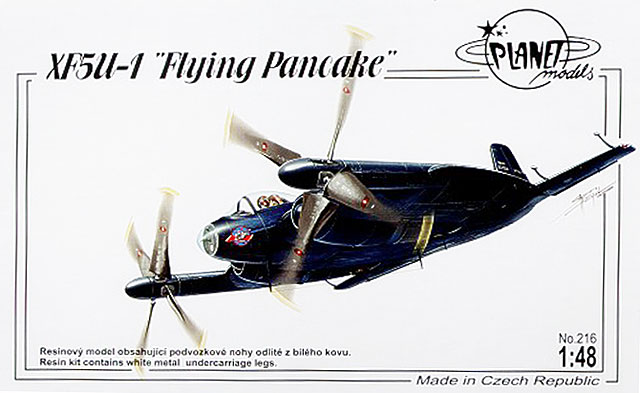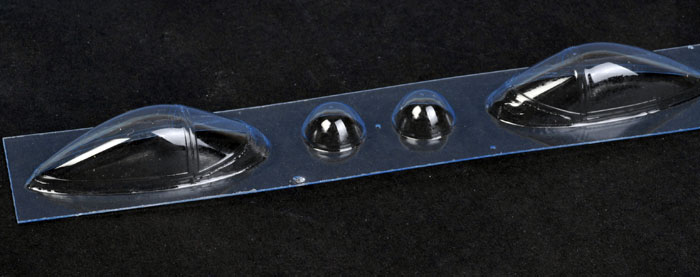XF5U-1 Flying Pancake

Planet Models, 1/48
scale
S u m m a r y : |
Catalogue Number: |
Planet Models kit number 216 - XF5U-1 Flying Pancake |
Scale: |
1/48 |
Contents & Media |
104 x cream resin airframe parts, 3 x white metal undercarriage legs, 2 x 2 vac-form canopies |
Price: |
Available online from Hannants for £41.91 and Modelimex for €55.50 |
Review Type: |
First Look |
Advantages: |
Simple to build and good quality, the white metal undercarriage is a nice touch. Good first resin kit. |
Disadvantages: |
Adequate decals, but lacking detail on the prop-blade logos. |
Conclusions: |
A nice simple kit of an interesting and attractive subject. |
Reviewed by
Mark Davies

Planet Models' 1/48 scale XF5U-1 is available online from Squadron.com
The flying pancake concept was introduced to NACA in 1933 by C H Zimmerman during a light aircraft competition. His unique design was to overcome the drag inducing wing tip vortices associated with low aspect ratio wings by the outboard placement of the propellers. The propeller wash was to limit what would otherwise have been disastrous amounts of induced drag at the long wing tips, caused by the movement of high pressure air from under the wing to the upper surfaces
Vought became interested in the concept and after a number of design studies so did the US Navy. The Navy sponsored the V-173 which was to prove the basics of the concept, including a zero length take-off into strong headwinds. The Vought XF5U-1 was a development of the theme proven with the earlier, simpler and much lighter Vought V-173, and was intended to lead to a naval fighter.
In addition to exploiting the manoeuvrability advantages of a very low aspect ratio wing the XF5U-1 was to have its manoeuvrability further enhanced by its propellers. The props were to have cyclic characteristics normally associated with helicopter rotors to provide a limited up and down movement, and therefore a change in the direction of prop-thrust. As proven with the earlier V-173, the XF5U-1 was expected to have very short take-off and landing characteristics.
Unfortunately the aircraft suffered from severe variational problems, and these prevented it being flown before the project was cancelled in 1947.
Regardless of its lack of success, the XF5U-1 makes for an extremely interesting modelling subject, and there will be many glad to have a good quality kit of this aircraft available in 1/48 scale.
Planet Models' 1/48 scale XF5U-1 Flying Pancake comes packaged in a stout top-opening box with appealing box art. The parts are in heat sealed plastic bags.
Straightforward instructions consist of four A4 pages giving the aircraft history in Czech and English. The parts map and constructional illustrations are photos of the actual kit being built and are clear to follow. Colour call-outs are given for the detail parts and airframe, but these are generic “Glossy Sea Blue” and “Yellow” etc. An FS number or paint brand number for the blue would have been more helpful. This said there is enough information around on US Navy colours of the period to ensure the builder uses the right colours.
The design of the kit is very well thought out. The upper and lower halves of the wing and fuselage are two pieces, and dominate the kit contents. The remaining resin parts cater for the cockpit interior, horizontal and vertical stabilisers, undercarriage doors, wheels, engine cooling intakes and props.
Over 100 resin pieces sounds a lot, but when you consider that there are eight prop blades, four main wheels etc the kit is in fact far simpler than the part numbers suggest. All the resin parts are typical for modern Planet kits with barely a pinhole to be seen, fine engraved surface detail, and adequate cockpit detail for the scale (no seat harness cast on the seat however).
The white metal undercarriage is well cast and a good idea given the almost solid resin airframe.
Thoughtfully two vac formed canopies and clear nose cones are provided, allowing for practice or insurance depending on how you look at it.

Decals are by Propagteam, and appear adequate, although the prop logos are rather simplified (a pity given the dominance of the prop-blades on this model).
This is a very well executed kit of an interesting subject. Despite its parts count it would still serve as a good introduction to resin kit building.
Thanks to MPM / Special Hobby for
the review sample
Review Text Copyright © 2009 by Mark Davies
Images from Modelimex website
Page Created 1 January, 2009
Last updated
1 January, 2009
Back to HyperScale Main Page
Back to Reviews Page |
